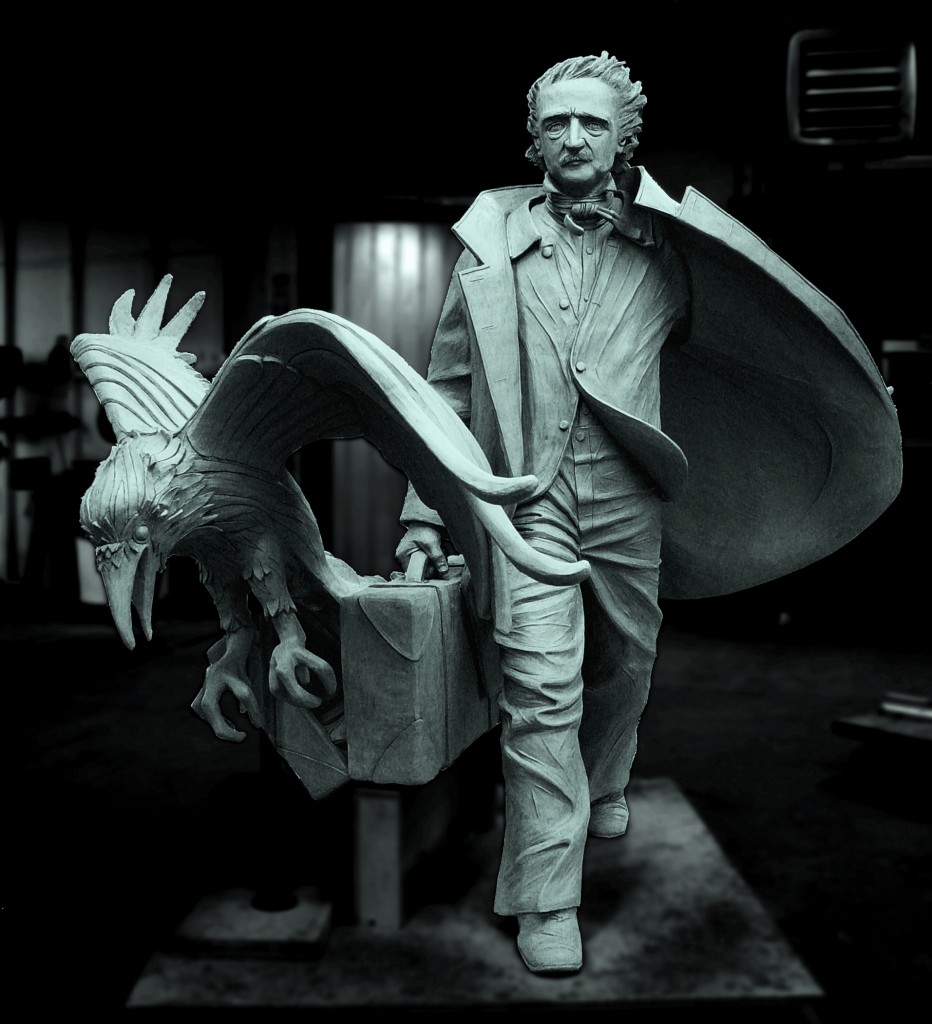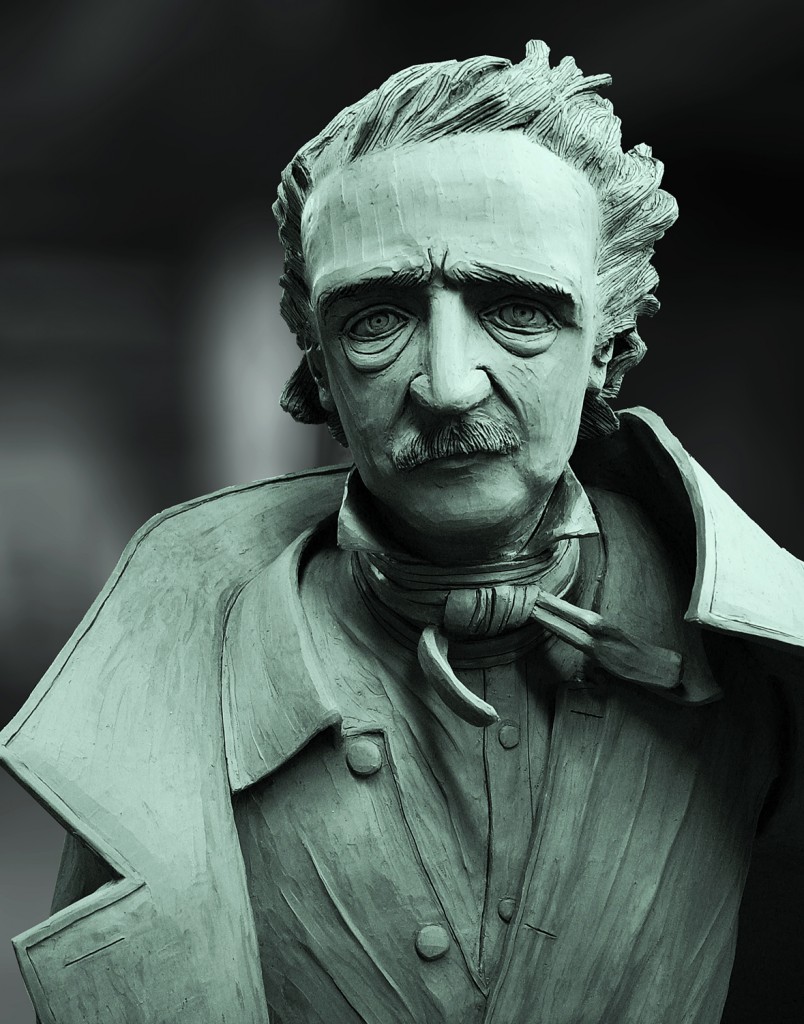
As many of us are fully aware, Boston can be a difficult place for one to plant their roots. Looking back in time to the 19th century, things weren’t much different. Celebrated author and poet Edgar Allan Poe may have had a tough time of it here in the Hub, engaging contentiously with local literati, but over a century later, Poe’s hometown holds him in the highest esteem. And so too will future Bostonians when they gaze upon the life-sized, bronze-cast statue of American literature’s most enigmatic writer.
The Edgar Allan Poe Foundation of Boston has worked tirelessly to reincarnate Poe in bronze in the center of his native city, and their efforts certainly are not in vain. Stefanie Rocknak, the artist responsible for bringing Poe back to life, recently completed work on the full clay statue and has since delivered it to the foundry (New England Sculpture Service) in Chelsea.
Rocknack won the coveted commission after duking it out against 265 other artists who applied from 42 states and 13 countries. She describes her design, titled Poe Returning to Boston, as “Just off the train, the figure would be walking south towards his place of birth, where his mother and father once lived. Poe, with a trunk full of ideas—and worldwide success—is finally coming home.” And of course, he’s accompanied by the fowl he’s synonymously and endlessly linked to: a raven.
BostInno chatted with Paul Lewis, chair of the foundation and a professor of English at Boston College, to find out more about the steps the foundation has taken to preserving Poe’s legacy, his quarrelsome connection to Boston and some fun facts we might not have known about him otherwise.
Poe was born on January 19, 1809 at 62 Carver Street – now 62 Charles Street South – and it was celebrating his bicentennial in 2009 that gave Lewis, and his constituents, the idea for commemorating his life forevermore.
Lewis helped run and promote a two-day literary program centered around Poe’s works, complete with a raven-topped cake, as well as a Boston Public Library exhibit aptly dubbed The Raven in the Frog Pond: Edgar Allan Poe and the City of Boston.
“Around this time, Dan Currie, an independent Boston historian who also worked on the exhibit, promoted the idea of creating a permanent statue to honor Poe and organized the Poe Foundation of Boston to work toward this goal,” Lewis told BostInno. “Honoring Poe calls attention not only to his birth here but to his career-long quarrel with the Boston writers and editors he called ‘Frogpondians,’ including Henry Wadsworth Longfellow, Ralph Waldo Emerson, James Russell Lowell and Cornelia Wells Walter.”
Poe’s father abandoned the family and his mother died a year later while he was young. Upon being orphaned, he was taken in by the Allan family of Richmond, Virginia. After a failed attempt at a collegiate career at the University of Virginia and a brief stint at West Point in officer training, he took his talents to Boston.
Though much of his literary success was conceived in the likes of Philadelphia and Baltimore, Poe kickstarted his career as a critic and reviewer in Boston, as well as that of an antagonistic relationship with Boston literary circles.
“[Poe] presented a controversial reading to the Boston Lyceum in October 1845, and spent the weeks following the reading in a pointed back-and-forth, he-said-they-said debate about his performance and literary taste,” explained Lewis further. “At the height of this debate, Poe wrote ‘The Bostonians are very well in their way. Their hotels are bad. Their pumpkin pies are delicious. Their poetry is not so good. Their Common is no common thing — and the Duck Pond might answer — if its answer could be heard for the frogs.'”
Perhaps adding fuel to the fire was Poe’s insatiable investigations into the lives of these authors who, as Lewis noted in a Boston Globe op/ed, were guilty of “what he saw as literary crimes and exposed a den of cronyism, imitation, and self-righteousness in the city that fancied itself the ‘Athens of America.'”
But it was here in Boston that he published his first collection of poems titled Tamerlane and Other Poems, his most famous short story, “The Tell-Tale Heart,” and his last works including “Hop-Frog,” “El Dorado,” and “For Annie,” thereby solidifying his reputation and influence in the annals of American literature.
Commissioning and commemorating a statue of the macabre man, though, has been perhaps less of a challenge than those Poe faced throughout his life, including his literary battles and frequent bouts with alcohol. Armed with a budget of approximately $200,000 and a bevy of buoyant benefactors, ranging from the Edward Ingersoll Browne Trust Fund and George B. Henderson Foundation Fund for the City of Boston to Boloco and Stephen King, the foundation hopes to unveil the finished product between June and October – perfectly timed for the eeriness of New England’s autumn.
The designated site of the the statue is at the corner of Boylston Street and Charles Street South, which Lewis explains was named “Edgar Allan Poe Square in April 2009” by Mayor Menino, who further “installed a historic street sign, and called for the creation of a permanent work of art in the square.”
For those looking to get involved and perhaps cushion the funding, donations of any amount can be made online at the foundation’s website here. And, if you’re a literary nerd like myself, and are interested in a keepsake, the foundation is offering a special edition Poe bobble head on eBay as a premium gift for a donation of $60, which includes domestic shipping.
Stay tuned to BostInno for the latest Edgar Allan Poe statue updates and be sure to chip in for your once-in-a-lifetime opportunity of keeping a miniaturized memento of one of the most manic-depressive authors of all time on your desk staring at you blankly on a daily basis.



